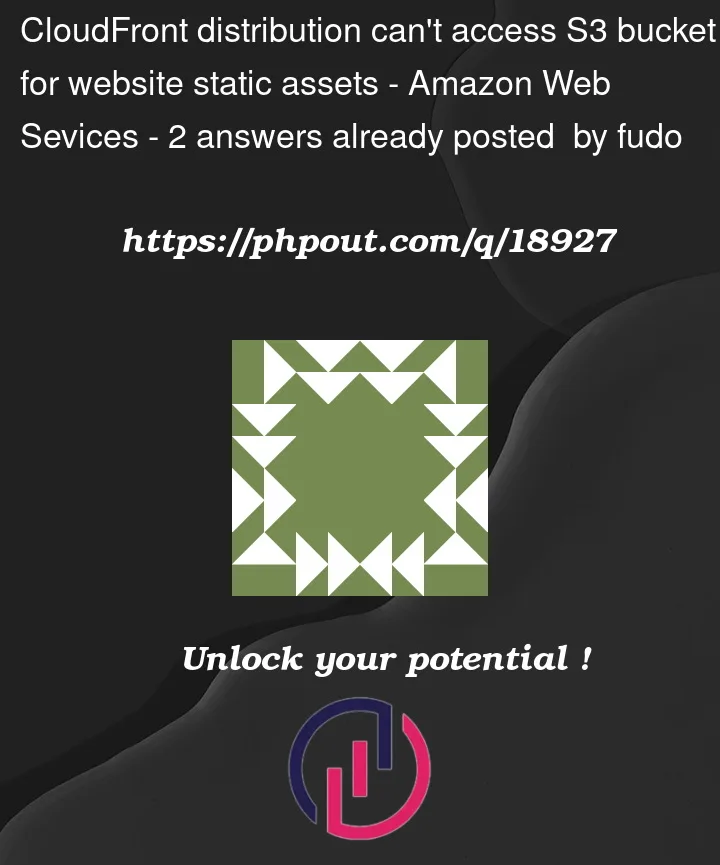This question follow a previous one, i decided to close that since the code changed a bit and the question did not reflect my actual situation any more.
The problem
I’m trying to deploy an S3 bucket hosting my static website asset and a cloudfront distribution to access it, but the distribution still return a bare csv file for an ‘access denied’ error:
As this docs page states in the blue Notice alert, I’ve not made the bucket a website endpoint, this way I can use an OAC to restrict access to its content.
A strange thing is that checking the distribution origin from the web console I see this blue alert, but the copyable policy is the same I found in the bucket permission at the given link.
I have no error during deploy, so it must be a silly configuration error, but it keeps giving me headaches since a week now and I can’t figure out what is wrong.
Bucket and object owners corresponds
Since mi website assets are uploaded to the bucket from a different project/pipeline i followed this guide to check if the bucket and the object owners were different but actually corresponds:
> aws s3api list-buckets --query Owner.ID
"3fdbd1e5cad4dd2bbf4c66a3dbaded6b888fdb67ff6aa6e66203a4107fe17b72"
> aws s3api list-objects --bucket my-test-bucket --prefix index.html
{
"Contents": [
{
"Key": "index.html",
"LastModified": "2023-01-20T11:05:38+00:00",
"ETag": ""52f2df5ddf8c35391f3f15a7614def58"",
"Size": 325,
"StorageClass": "STANDARD",
"Owner": {
"ID": "3fdbd1e5cad4dd2bbf4c66a3dbaded6b888fdb67ff6aa6e66203a4107fe17b72"
}
}
]
}
CloudFormation template
Resources:
BucketPolicy:
Type: 'AWS::S3::BucketPolicy'
DependsOn:
- AppBucket
- CloudFrontDistribution
Properties:
Bucket: !Ref AppBucket
PolicyDocument:
Id: MyPolicy
Version: '2012-10-17'
Statement:
Sid: PolicyForCloudFrontPrivateContent
Action: s3:GetObject
Effect: Allow
Principal:
Service: cloudfront.amazonaws.com
Condition:
StringEquals:
AWS:SourceArn: !Sub arn:aws:cloudfront::${AWS::AccountId}:distribution/${CloudFrontDistribution}
Resource: !Sub arn:aws:s3:::${AppBucket}/*
CloudFrontDistribution:
Type: AWS::CloudFront::Distribution
DependsOn:
- AppBucket
- DefaultCachePolicy
- DistributionOAC
Properties:
DistributionConfig:
Enabled: true
Origins:
- Id: AppBucket
DomainName: !GetAtt AppBucket.DomainName
OriginPath: /*
S3OriginConfig: {}
OriginAccessControlId: !Ref DistributionOAC
DefaultRootObject: index.html
DefaultCacheBehavior:
ViewerProtocolPolicy: redirect-to-https
TargetOriginId: AppBucket
CachePolicyId: !Ref DefaultCachePolicy
DistributionOAC:
Type: AWS::CloudFront::OriginAccessControl
Properties:
OriginAccessControlConfig:
Name: ExampleOAC
OriginAccessControlOriginType: s3
SigningBehavior: always
SigningProtocol: sigv4
AppBucket:
Type: 'AWS::S3::Bucket'
Properties:
BucketName: 'test-spa-stack-bucket-app'
PublicAccessBlockConfiguration:
BlockPublicAcls : false
BlockPublicPolicy : false
IgnorePublicAcls : false
RestrictPublicBuckets : false
DefaultCachePolicy:
Type: AWS::CloudFront::CachePolicy
Properties:
CachePolicyConfig:
Name: test-cache-policy
DefaultTTL: 10
MaxTTL: 10
MinTTL: 1
ParametersInCacheKeyAndForwardedToOrigin:
CookiesConfig:
CookieBehavior: none
EnableAcceptEncodingBrotli: true
EnableAcceptEncodingGzip: true
HeadersConfig:
HeaderBehavior: none
QueryStringsConfig:
QueryStringBehavior: none






2
Answers
Ok, I found a YT video that worked from cloud console, then I replicated it via CloudFormation stack template.
I think that my problem could be caused from either of these configurations:
cuket owner enforcedpolicyworking template
You aren’t to have much luck without using legacy OAI (for no reason).
So, here’s a policy you can use for target S3 bucket after you create the OAI right there in Cloudfront:
After you do that, it should return expected content.
If it does work for you and you start asking why, you’d better find something better to do.